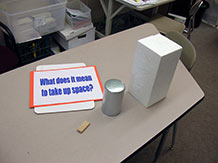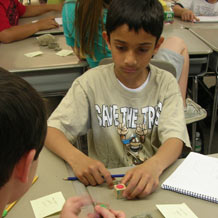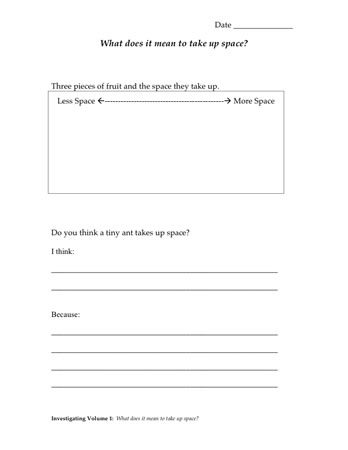What does it mean to take up space?
Plan Investigating Volume 1
Children are keenly aware of the size of things, especially big, bulky things that get in their way or are too unwieldy for their small bodies to handle. But the concept of volume is probably new to them, and it can be difficult for them to separate it from other measures that also describe an object’s size (e.g., weight, height, length, area, and perimeter).
In this investigation students consider what it means to “take up space.” First they brainstorm about the three dimensions of space, and then they order a set of objects by the amount of space they take up. By the end of the investigation, students will be thinking about volume as a property of objects different from weight. They will also have the beginnings of a “volume line.”
Learning Goals
- to consider what it means to “take up space”
- to compare the amount of space that objects take up
- to become familiar with the term “volume”
| Sequence of experiences | ||
|---|---|---|
| 1. Ask the question | All Class | 15 Mins |
| 2. Order objects by how much space they take up | Small Groups | 15 Mins |
| 3. Make meaning | All Class | 15 Mins |
Materials and Preparation
For the class:- Post the investigation question in a place where all students can see it
- 1 block of Styrofoam (approx. 10 cm x 10 cm x 20 cm)
- 1 pillar candle #1 (approx. 8 cm diameter x 16 cm tall)
- 1 small maple block (from 4 piece wood block set)
- Several creations from the 10–10–10–10 Challenge, if available
- 1 small cube (cubic centimeter block)
- 1 copper cube (from the set of materials cubes)
- 1 pine cube (from the set of materials cubes)
- 1 100–gram piece of plastic modeling clay
Notebook Pages
1. Ask the question
Ask children to bring some of their creations from the 10–10–10–10 Challenge to the circle (if available). Recall the materials they were given to work with: 10 grams of Styrofoam, 10 grams of aluminum foil, 10 grams of wooden stirrers, and 10 grams of plastic modeling clay.
- All four materials weighed exactly the same — 10 grams. What differences did you notice about how much of each material you were given?
If students reply that there is “more of” some materials than others, or that the portions were “bigger,” challenge them:
- But they weigh the same. What do you mean? What is different?
Let them struggle to describe the difference until they arrive at a consensus that some materials “take up more space,” or have a “bigger shape,” or “hold more air.” Then pose the new investigation question:
Talking points: This investigation introduces the concept of volume, but use the more descriptive phrase “takes up space” until the very end of the session. This phrase is more readily understood by children and it underscores the three–dimensional nature of the concept.

As the children talk about space, size and shape, make sure they are not thinking only of height and length. Listen for language that indicates they are thinking three–dimensionally, words like back, front, top, bottom, back and forth, sideways, inside, outside, all over, all around, altogether, everywhere, the whole size, the whole shape, holding air, “like a box.”
- How many sides does space have? How could we ever measure it?
As the discussion winds down, tell students that, just as objects have height and weight, every object also takes up space. Put the tall pillar candle on the floor and use your hands to define the amount of space the candle takes up, moving two hands around and above the candle, to illustrate how much space this candle takes up.
Modeling 3–dimensional objects: To demonstrate the meaning of how much space an object takes up, use both hands, in motion, to show all of the physical boundaries of an object — its top and bottom, its left and right boundaries, its front and back boundaries. By keeping your hands in motion, you focus attention on the size of the whole object — not only its height or length — and embody the three–dimensionality of the concept.
Next place the maple block beside the candle and move your fingers around the block in a similar way, to illustrate how much space the wood block takes up.
Finally, invite some comparisons:
- Which object takes up more space, the candle or the block of wood?
- What about this block of Styrofoam? How does it compare?
Leave the Styrofoam block, pillar candle, and maple block in order for later reference.
2. Order objects by space
This is the heart of the investigation, where students put objects in order according to volume, here expressed as “the amount of space they take up.” Four objects are provided — three cubes and the plastic modeling clay — others students must imagine (three fruits).
Note: The cubes are a test to see whether students can separate volume from weight. Since the cubes are the same size, they should be set side by side, but some students may still be seduced by weight. Do some think the heavier copper cube takes up more space than the pine cube? If so, recall their earlier observations about “heavy for size” and “light for size.”

These students are uncertain where to put the two cubes. They are the same size, but have different weights. Where should they go?
Give each group the three cubes and the plastic modeling clay to put in a line according to the amount of space they take up. The task will be straightforward unless the students become sidetracked by weight. Do they heft the objects to compare their weights? Do they talk about “heavier” and “lighter”? If so, remind them they are not comparing weight anymore. Tell them that they should be using their eyes and not their sense of felt weight to order things by how “much space they take up.”
As students finish, have them draw the four objects, in order, in their notebooks, labeling each object. If there is more than one opinion about the order, each student can record the order that seems correct.
As a group finishes ask each student to think of three pieces of fruit: one that takes up a lot of space, one that takes up very little space, and one in between. Have students draw and label the three pieces of fruit in their notebooks. This thought experiment is a higher–order exercise, requiring students to consider volume without handling the objects. If they need help, perhaps suggest that they model the fruit in the air with their hands.
3. Make meaning
Purpose of the discussion
The purpose of this discussion is to consolidate students’ learning about what it means to take up space and to introduce the term “volume.”
Have students bring their investigation materials (the centimeter cube, the copper and pine cubes, and the 100g plastic modeling clay cube) to the discussion. Ask if any one group disagreed about how to order the cubes and plastic modeling clay. If yes, have that group to put their set of cubes in order. What does the rest of the class think? Resolve any other uncertainties in the same way.
Engage students in the focus question
Who can combine their line of 4 cubes with the order line we made earlier (with the Styrofoam, candle, and wooden block) so that there’s a single line of objects ordered by the amount of space each of the objects takes up?
Take volunteers but have the whole class consult on the exercise, stopping only when you have consensus. Leave this merged order line set up in the classroom for later reference.
Ask different students to share their ‘three fruits’ orders with the rest of the group. If there’s time, have students say where some of the fruits might go in the class order line.
Finally, return to the investigation question: What does it mean to take up space? Are students learning to see the three–dimensional space that an object occupies, and to compare the magnitudes of these spaces across a set of objects? Do they understand how it is different from height and length and weight? Do they think they’ll be able to add new objects to this new order line?
Let students know that the amount of space an object takes up is called volume. Explain that “volume” can also mean an “amount of sound,” like “Turn up the volume on the TV,” but for this unit the class will be using “volume” to mean “amount of space.”
Leave students with these questions to think about:
- How can we describe the amount of space an object takes up?
- How in the world can we measure volume?







